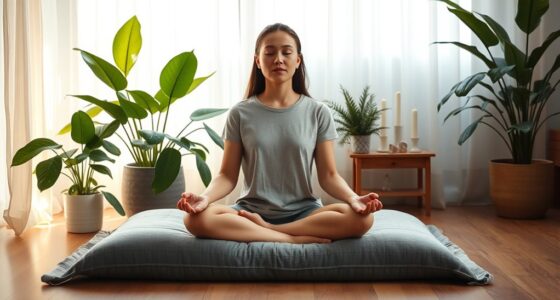By combining meditation and reflection, you deepen self-awareness and gain mental clarity. Meditation helps you focus on present sensations and observe thoughts without judgment, creating a calm space. Reflection through journaling allows you to explore and understand those thoughts and feelings more deeply. Practicing regularly enhances your ability to recognize emotional triggers and subtle shifts in your mindset. Keep exploring this approach to unearth greater insight and develop effective strategies for clarity and emotional balance.
Key Takeaways
- Practice mindfulness techniques before journaling to clear the mind and enhance self-awareness.
- Use reflection to identify recurring thought patterns and emotional triggers.
- Journaling insights from meditation deepens understanding of emotions and mental clarity.
- Consistently combine meditation and reflection to recognize subtle mental shifts over time.
- Establish a routine to foster self-discovery, reduce stress, and develop better emotional management strategies.

Many people find that combining meditation and reflection can deepen their self-awareness and promote mental clarity. When you integrate mindfulness techniques into your routine, you’re actively engaging in practices that help you stay present and attentive to your thoughts, feelings, and physical sensations. This focus lays a solid foundation for reflection, allowing you to observe your inner experiences without judgment. As you develop this awareness, journaling practices become a powerful tool to capture insights, track emotional patterns, and clarify your thoughts. Writing down your reflections helps solidify your understanding and uncovers underlying themes that might otherwise go unnoticed.
Combining meditation and reflection fosters self-awareness, mental clarity, and deeper understanding of your thoughts and feelings.
To start, you might set aside a few minutes for mindfulness techniques before you begin journaling. Sit comfortably, close your eyes, and breathe deeply. Pay close attention to your breath, sensations in your body, or sounds around you. This quiet moment of mindfulness clears your mind, creates space for reflection, and cultivates a state of calmness. Once you feel centered, open your eyes and begin your journaling practice. Write freely about what you’ve observed during your mindfulness session—any emotions, thoughts, or insights that surfaced. This process helps you connect the dots between your present experience and your deeper motivations or concerns.
Using mindfulness techniques during meditation can also help you identify recurring thought patterns or emotional triggers. As you notice these during your practice, you can then explore them further through journaling. For example, if you recognize feelings of anxiety or frustration, jot down what triggered those emotions and how they manifest in your body and mind. Reflecting on these notes later allows you to gain perspective and develop strategies for managing similar situations outside your meditation time. Over time, this cycle of mindfulness and journaling enhances your self-awareness, enabling you to recognize subtle shifts in your mental and emotional states. Incorporating filtration efficiency and proper technique can ensure that your reflection process is free from distractions and debris, allowing for clearer insights.
Consistency is key. By regularly practicing mindfulness techniques and journaling, you’ll begin to notice patterns and gain clarity about what genuinely matters to you. This clarity informs your daily decisions, reduces stress, and helps you respond more consciously rather than react impulsively. Incorporating both practices doesn’t have to be complicated; even a few minutes each day can make a significant difference. As you continue, you’ll discover that this combined approach isn’t just about calming the mind but also about deepening your understanding of yourself and cultivating a more intentional, fulfilling life.
Frequently Asked Questions
How Long Should Each Meditation Session Last?
You should aim for a meditation duration of about 10 to 20 minutes, which is long enough to calm your mind without feeling overwhelming. For reflection, spend roughly 5 to 10 minutes to process your thoughts. Adjust these lengths based on your experience; if you’re new, start with shorter sessions and gradually increase as you become more comfortable. Consistency is key to gaining clarity from both practices.
Can Reflection Replace Meditation Entirely?
Reflection can’t fully replace meditation, like a single brushstroke can’t create a complete masterpiece. While reflection enhances emotional awareness and deepens mindfulness techniques, meditation offers a focused mental space that clears your mind. To achieve clarity, combine both practices; reflection helps process emotions, and meditation cultivates mindfulness. Together, they create a balanced approach that nurtures mental clarity, making your journey more enriching and effective.
What Are the Best Environments for Combined Practice?
You should choose environments that support your focus and minimize distractions for combined meditation and reflection. Look for a quiet space with comfortable seating and minimal ambient influences like noise or strong light. Ideal environments include a peaceful corner at home, a tranquil park, or a dedicated meditation room. By selecting the right environment, you enhance your clarity and deepen your practice, making it easier to connect with your inner thoughts and achieve mental calm.
How Do I Stay Consistent With Daily Practice?
To stay consistent with your daily practice, you should integrate mindfulness techniques into your routine and focus on habit formation. Set a specific time each day, create a dedicated space, and keep reminders to reinforce your commitment. By making your practice enjoyable and linking it to daily activities, you’ll develop a habit that sticks, helping you stay focused and clear-minded through regular meditation and reflection.
Are There Specific Topics to Focus on During Reflection?
Focusing on feelings, frustrations, and goals can fuel your reflection sessions. Use journaling prompts that prompt mindfulness techniques to explore deeper into your emotions and experiences. Think about recurring patterns, personal progress, or specific challenges. By honing in on these topics, you create clarity, cultivate compassion, and connect with your core. Regularly revisiting these areas helps you stay centered, strengthen self-awareness, and sustain your meditation and reflection routine.
Conclusion
By blending meditation and reflection, you clear your mind and find fresh perspectives. This practice helps you stay grounded and make thoughtful decisions amidst chaos. Remember, “A wise man learns more from his enemies than from his friends,” so embrace challenges as opportunities for growth. Keep practicing consistently, and you’ll discover greater clarity and inner peace. Trust the process—your mind is your most powerful tool for transformation.
Felicity, our Author, pens in-depth articles and guides that delve into the heart of personal discovery. Her narrative-driven approach weaves together theory, practice, and personal anecdotes, making the journey of self-exploration both relatable and inspiring. Felicity’s contributions help illuminate the path for those seeking a deeper understanding of themselves and their relationships.










